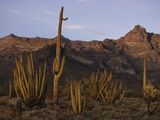Desert Biome
Desert biome are extremely dry environments that are home to well-adapted plants and animals. The main types of deserts include hot and dry deserts, semi-arid deserts, coastal deserts, and cold deserts.
Organ Pipe Cactus
For upon | The Organ Pipe Cactus National Monument in Arizona is full of life despite its arid, desolate appearing landscape. This part of the Sonoran Desert of home to a variety of animals including bats, the kangaroo rat, and the night-blooming cereus cactus.
The desert biome covers about one-fifth of Earth’s surface. This biome has a layer of soil that can either be sandy, gravelly, or stony, depending on the type of desert. Deserts usually get at most 50 centimeters (20 inches) of rainfall a year, and the organisms that live in deserts are adapted to this extremely dry climate.
Plants in deserts have adaptations to conserve water. For example, cacti have enlarged stems to store water, as well as spines to protect these water reserves from thirsty animals. Animals such as the black-tailed jackrabbit (Lepus californicus) are also adapted to life in the desert: Their extra-long ears help to transfer excess heat from their body into the air.
The four main types of deserts include hot and dry deserts, semi-arid deserts, coastal deserts, and cold deserts. In hot and dry deserts, also known as arid deserts, the temperatures are warm and dry year-round. Some famous arid deserts include the Sahara Desert which covers much of the African continent and the Mojave Desert located in the southwest of the United States. Semi-arid deserts are a bit cooler than hot and dry deserts. The long, dry summers in semi-arid deserts are followed by winters with some rain.
Semi-arid deserts are found in North America, Greenland, Europe, and Asia. Coastal deserts are a bit more humid than other types of deserts. Although heavy fogs blow in from the coast, rainfall is still rare. The Atacama Desert of Chile in South America is an example of a coastal desert. Cold deserts are still dry but have extremely low temperatures in comparison to the other types of deserts. The Antarctic is an example of a cold desert.

The Organ Pipe Cactus National Monument in Arizona is full of life despite its arid, desolate appearing landscape. This part of the Sonoran Desert of home to a variety of animals including bats, the kangaroo rat, and the night-blooming cereus cactus.
Walter Meyers Edwards
The article was originally published here.


Comments are closed.